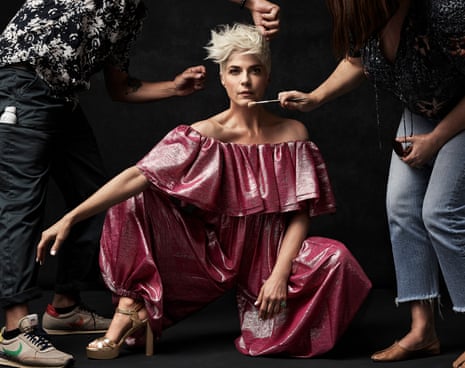Selma Blair is telling me a joke about three tampons walking down the road: heavy flow, medium flow, and light flow, only I’ve been warned by her representatives that she can only do these video chats in half-hour bursts, and we’re heading for minute 40 if I don’t make her stop. “No, let me finish this joke!” she insists, heading into a wildly funny and absolutely unprintable punchline.
It is morning in Los Angeles and Blair needs to conserve energy for the doctor: five hours of plasma treatment at home will follow this interview – part of her regular procedures since having stem-cell treatment for the multiple sclerosis that was diagnosed in 2018. I first interviewed her shortly before then, when she was working on the Netflix sci-fi series Another Life, with no idea what lay ahead of her (or the world.) We had lunch at the glamorous Chateau Marmont and cackled about being single mothers with the same bleak sense of humour. Soon after, she went into isolation, and then the world followed – something she found almost comforting, as if we all got diagnosed together.
“I get to lie down for five hours today, so it’s a spa day,” she says, grinning in typical nonchalance about having her plasma replaced. She recently had yet another MRI scan and was warned she’d have to stay in the tube for an hour, which sounded wonderful, nobody trying to call her, “Lying on my stomach with a pillow like I was golden.” As a child, she would leave welcome home notes for her mother, and is trying to convince her 10-year-old son Arthur to do the same for her, “only I never leave the house now. So how about, welcome to bed! Welcome to staying in.”

Spa days looked quite different back in the actor’s Hollywood heyday, when Blair co-starred in films such as Cruel Intentions and Legally Blonde, as well as cult hits Hellboy and Storytelling, and played Kim in the American remake of the utterly hilarious Kath & Kim. Not that the 49-year-old from Michigan was ever the luxurious, pampered sort of celebrity, remaining more of a cult figure. She knows now that a lot of her ambiguities at the time came from all the unexplained pain that she was in. She would constantly beat herself up about her shortcomings, always seeing herself only as the sidekick part, almost unwilling to try as hard as she could at acting, she says now, or to make herself bigger. “I must admit, I was miserable. I was sometimes funny and miserable, and full of love – I’ve never been a hateful person. But there was a melancholy of grief, always, and always a grief of isolation because I didn’t last long talking, you know, not knowing I had MS. The fear that I’m just lazy still comes into my mind.”
Now she has worked with director Rachel Fleit to make a documentary, Introducing, Selma Blair, which is the most open, exposing celebrity piece I can ever imagine seeing; a work of cinéma vérité. The opening scenes are also utterly hilarious, which is quite something, considering it’s a film about having stem-cell treatment. The camera follows Blair around her house in the hills above Studio City, Los Angeles, as she puts on makeup sent to her by her friend Kim Kardashian West, from Kim’s own brand, “because, God knows, no one knows who she is and I’m just trying to get this girl a little support.”
She uses the bronzer to “culturally appropriate” some cheekbones into her deeply pallid face, makes herself quite hysterical messing around with a pair of miniature rubber hands, and explains her decision to walk with a stylish black cane rather than a regulation mobility aid. “Make it fashion!” (You can get them for $10 on Amazon, she adds.) And then the dystonia kicks in, her voice starting to slur and movement becoming visibly harder. It is as if she goes into slow motion while the rest of the film stays at speed.

But this is all Blair at her Vaudeville best, the circus ringleader of her own dance, fiendishly scorching her own earth. The same Blair who turned up to the Vanity Fair Oscars party in 2019 with her new walking stick as part of her look: glamorous, disabled, proud. You watch these moments and wonder why Hollywood never did something entirely different with her feline cleverness. Guillermo del Toro used to tell her she was the only actor he had ever encountered, apart from Joaquin Phoenix, who would see the camera coming and turn her back on it.
“And now I know, for me to work on film or TV, if I do that, I would have to be a much more thoughtful, present actress. Being able to use my weirdisms, my tics. I’m pretty comfortable with my body now and unapologetic about that. And I think there’s room for some of that.” But even in a role that allowed for it, she would still need enough energy to get through the work. She cites the “spoon theory” that she learned from her new friends in the chronic illness community. Invented by Christine Miserandino, it describes having to use up all the day’s energy on different spoons of activity.
“You learn to think to yourself, ‘OK I’ve really only got two spoons today, so don’t shower, and I can’t eat yet because I don’t have time to vomit. And the lights and the stimulus on set, all the things I normally love, can leave me quite befuddled. My mind will trip up.” (During our conversation, she has bursts of fantastic ideas, and then sometimes has to stop to ask me what we were talking about.)

After her diagnosis she became close to the actor Michael J Fox, and remembers telling him how amazing it was that he was making a show about having Parkinson’s. “And he said, ‘Yeah, the only problem is… I’ve got Parkinson’s.’”
Other celebrities have also come through for her, since she announced her condition in an Instagram post and gained a whole new level of fame, with millions of followers flocking to learn about her new life. Her old friends the Kardashians, the model Jaime King. It was Jennifer Grey, the star of Dirty Dancing, who first suggested stem cell treatment, passing on the details of her doctor brother. The film shows Blair in chemo and isolation in a hospital on the other side of the country, when, in a cruel twist of fate, her mother was dying of cancer at the same time, so couldn’t offer support.
“So I went through my DMs,” she explains, roaring with laughter at her response to motherlessness and singleness, “and all the people that I admired – I grabbed it. I called them. I called Kris Jenner. I didn’t know Michelle Pfeiffer but she DMed a well-wisher and you know, I got on that call! When I was screwed up on Dilaudid [an opioid] and scared because I had got a bit of an embolism, I really needed a voice that had some shit together, like a mother.”
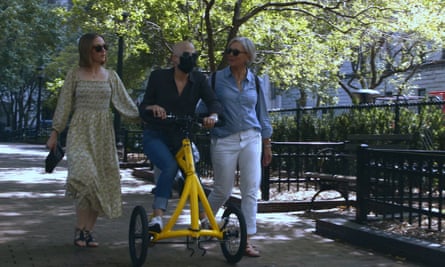
She does an impression of how she spoke to these people: “‘I’m scaaared and you’re an idol to me and I feel better just knowing you checked in on me!’ It did wonders for me to have that mother feeling that I substituted with all these great women. And men! JJ Abrams! People that would never give me a job came forward! Oh, I joke, haha – but they came forward as people, and this town has a history, and I do have a history with it, and I love these people. I love this town. I love how it can influence things for the better.”
I wonder how else the diagnosis has changed her life. “Well, I’ve developed some affectations, as my mother would say. I like to talk in a British accent,” she deadpans, drawing out the posh vowels. It has been a huge positive to find out what has been going on for as long as she can remember – unexplained pain in so many parts of her body since childhood. “Recurring trigeminal neuralgia [stabbing face pains], dystonia, dental work, constant neck and nerve pain, down my leg, my joints, plus the pseudobulbar affect – some things that were contributing to my comfort level in life,” she says, with comic understatement. She never experienced joy before the diagnosis; now she thinks she might know what it is.

Her beloved son Arthur was born 10 years ago, which is when her health really took a nosedive – the doctors couldn’t understand why the epidural only seemed to work on one side of her body: “Nothing was connecting, nothing added up.” Afterwards she attributed her worsening symptoms to postnatal mental health, because nobody ever suggested an MRI scan. She had never been good with alcohol, and would use it to self-medicate the pain away. “I wasn’t someone who was drinking on set and having a party. I was someone that went into isolation for a glass of oblivion. I really did have trouble being sober.” Her relationship with her son’s father, Jason Bleick, who works in fashion, broke down pretty early on, and things came to a head when they tried to co-parent on a family holiday to Mexico in 2016.
“Jason and I had gone through some very, very difficult custody mediations. You know, we were really trying our best, both of us, but we were well short of being comfortable with each other. When I went on that trip I was not drinking, but my health was really awful. And I was having these crazy panic attacks, as if I just couldn’t be in my skin.” They got off the plane in Mexico and found their hotel was an all-inclusive resort, her in the presidential suite and him in the room next door, with their son going between them.
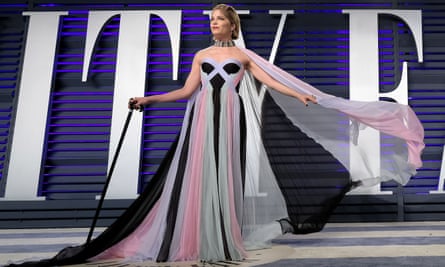
Her suite, to her horror, turned out to be “a wonderful drinking mall. It had a full bar. And as soon as my pain set in, and the rain started, I thought I will just have one shot to calm the pain in my face, that I had chased around with root canals and extractions that I didn’t need, because I was so desperate. And Jason looked at me… I was like, ‘Trust me, I know what I’m doing.’ I didn’t want to give him more reason to distrust me, but I was just at my wits’ end.”
By the return flight she was having what seemed to be a psychotic episode, ranting and raving about somebody burning her. She was escorted off the plane on a stretcher, with footage of the incident being plastered all over the American tabloids. When she got home her lawyer called, asking if child protective services were required. “I thought, oh my God, it’s come to this. This is what I’ve done.” She vowed never to drink again (and hasn’t) and appeared on US chatshow The Talk, to address the scandal. “I knew I was dealing with something physical that I couldn’t quite explain on TV. I remember saying on the show, ‘I’m really trying to forgive myself for this.’”
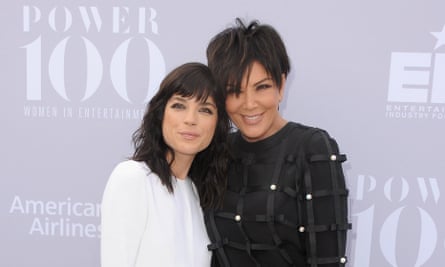
Finally, at 10pm one night, she was given an MRI scan. At 11pm the doctor told her she had multiple lesions all over her body “and that I must have had them for years”. Blair has brain damage now; her mother had something similar before she died. “And my mother was very protective of her brain. Her brain was brilliant. She was a magistrate, court appointed through every administration, Republican, Democrat, everyone always reappointed Molly. She was my own Ruth Bader Ginsburg.” Losing her was worse than MS, says Blair. “It was the spookiest, hardest thing I’ve gone through. I cannot tell you how much I love and worship my mother. It’s intense.”
In the film we also discover her mother was very critical of her, capable of great unkindness. While the film doesn’t outright claim that this psychological pain contributed to Blair’s physical symptoms, it doesn’t not claim it either. “How can you say the brain and body are different?” she muses out loud, to me. “I’m only reckoning now how much the emotions in the brain and in the body are truly connected, and, until recently, I don’t think people took that seriously.”
Yet since filming finished, Blair has been clearing through both her and her mother’s possessions, in an attempt to Marie Kondo her life. Things feel very different in hindsight. “I think now I was a horrible daughter. I see how I must have done horrible things. I see all the letters she wrote me and I don’t think she wrote to any of my other sisters. I must have not read them word for word, even though I thought I did, but now I read them word for word and she was a spectacular mother. Not the kind that I wanted, of hugs or throwing the football to me, but she loved me dramatically, fiercely.” She cries a little. “I miss her every day and I talk to her and I don’t care. I light a cigarette and just let it burn because that was what she did.”

There is an incredible scene in the film where, some time after her mother’s death, Blair calls her mobile phone, and is gleeful on hearing her recorded voice, the voicemail still on. So she leaves her a message. “Mom!” She cackles into the phone, delighted, emboldened, surprised. “Get this – you’re fucking dead!” She rings off and turns to the camera. “She would have found that so funny,” she says.
We talk over a couple of days and I keep trying to get Blair to criticise Hollywood, to look back at its culture of the body beautiful from her new perspective and dismiss it, but she doesn’t play by any rules, including the one of saying what you want to hear. “Let’s face it, we love the body beautiful,” she says, “because usually that means it’s in a state of health. It’s working well.”
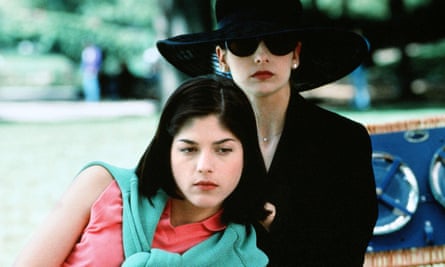
She mentions Willie Garson, the actor who played Stanford in Sex and the City, who recently died. “Willie brought laughter and kindness and he let people like me, who weren’t perfect-looking, think yeah, I have a shot at being an actress.” (By Hollywood standards, she means, because right now, including her hair that is short since the chemo and bleached to hide the bald alopecia patches, she looks incredible.) “You know, it was just – I’ve loved every minute of this Hollywood. I love my son and I love this Earth and I love Hollywood. I would love to see it be a changemaker, almost imperceptibly. I don’t want to shove things down people’s throats.” She made her own film because she is still learning about stem cell and thinks people with other illnesses could use it too, even though it didn’t fix everything for her. “I was waiting for that morning where, oh my God, I wake up and I feel like everyone else. And that morning has not come. But new lesions are not forming, and they’re not flared, not on fire, now.” She also wonders if people will laugh at her, but then says that isn’t the point, the film is for other chronically ill people to see someone who resembles them up there.
“You know, this wasn’t a death sentence for me. We all have a death sentence somewhere written in the stars. And hopefully, we will all learn to live our lives before that death sentence starts.”
Introducing, Selma Blair is available to stream on Discovery+ from Thursday 21 October
Stylist Elizabeth Stewart at Wall Group; hair Christian Marc at Forward Artists using Oribe; makeup Rachel Goodwin using Augustinus Bader at A Frame Agency; nails Sarah Chue for Exclusive Artists using OPI – Funny Bunny
